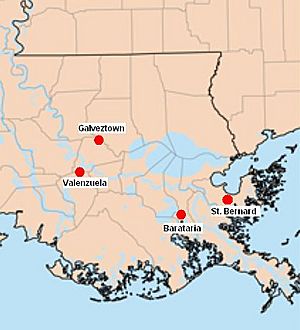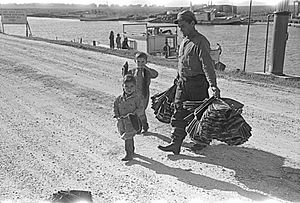Isleños facts for kids
|
|||||||||||
| Total population | |||||||||||
|---|---|---|---|---|---|---|---|---|---|---|---|
| Canarian diaspora unknown |
|||||||||||
| Regions with significant populations | |||||||||||
| 42,671-600,000 | |||||||||||
| 30,400-900,000 | |||||||||||
| 37,008 | |||||||||||
| 2,390 | |||||||||||
| 628 | |||||||||||
| 620 | |||||||||||
| unknown | |||||||||||
| unknown (by ancestry), 1,600 (by birth) | |||||||||||
| unknown | |||||||||||
| unknown | |||||||||||
| Languages | |||||||||||
| Spanish, English, French (in Louisiana) | |||||||||||
| Religion | |||||||||||
| Roman Catholic | |||||||||||
| Related ethnic groups | |||||||||||
| Canary Islanders, Guanches, Spanish, Portuguese | |||||||||||
Isleños (pronounced is-LAY-nyos) are people whose families came from the Canary Islands. These islands are part of Spain, located off the coast of Africa. The word isleño means "islander" in Spanish.
For hundreds of years, many people from the Canary Islands moved to different parts of the Americas. They settled in places like Louisiana, Puerto Rico, Cuba, Venezuela, and the Dominican Republic. They were called isleños to tell them apart from people who came from mainland Spain.
Today, the term isleño often refers to the special culture of these Canary Islanders and their descendants. Their traditions, language, and even food have influenced the places where they settled. In some areas, like Saint Bernard Parish in Louisiana, their unique culture and language are still very much alive.
Contents
The History of Isleño Migration
People from the Canary Islands started moving to the Americas very early, around the time Christopher Columbus made his first voyages in the late 1400s. The Spanish government wanted to settle new lands in the Americas. They often sent groups of Canarian families to help build new towns and communities.
Why Did Isleños Leave the Canary Islands?
Life in the Canary Islands was often very hard. Many people faced poverty and a lack of jobs. The Spanish government even created a rule called the Tributo de Sangre (Blood Tribute). This rule meant that for every thousand tons of goods shipped from the Americas to Spain, 50 Canarian families had to move to the Americas. This was meant to help populate areas with fewer Spanish settlers.
Volcanic eruptions, droughts, and pirate attacks also made life difficult on the islands. These challenges pushed many Canarians to seek a better life in the Americas. They hoped to find land to farm and new opportunities.
Where Did Isleños Settle?
Canarian families moved to many different places. They went to Venezuela, Cuba, the Dominican Republic, and Puerto Rico. Some also settled in Uruguay, Mexico, Argentina, and the southern parts of what is now the United States.
After many Latin American countries became independent from Spain, Cuba and Puerto Rico remained Spanish colonies for a while. Many Canarians continued to move there, often working hard for very low pay. Over time, as the economy in the Canary Islands improved, fewer people left.
Isleños in the United States
During the 1700s, Spain sent Canarian families to its colonies in what is now the southern United States. The goal was to establish Spanish communities.
Isleño Communities in the United States
- San Antonio, Texas: In 1731, 16 Canarian families arrived and helped found San Antonio.
- Spanish Florida: Between 1757 and 1759, 154 families were sent to Florida. However, many later moved to Cuba when Florida became British or American territory.
- Spanish Louisiana: From 1778 to 1783, about 2,100 Canarians came to Louisiana. They started four communities: Galveztown, Valenzuela, Barataria, and San Bernardo.
- San Bernardo was the most successful of these settlements. The Isleños there were able to keep much of their unique culture and language alive for many years.
Isleños in the United States played a part in important historical events. They fought in the American Revolutionary War, the Battle of the Alamo, the American Civil War, and both World Wars. The special Spanish dialect spoken by older Isleños in San Antonio faded out by the 1950s, but it is still spoken by some in St. Bernard Parish.
Isleños in the Caribbean
The Isleños in Louisiana share some cultural ties with people in Cuba, Puerto Rico, and the Dominican Republic. This is because all these places received many settlers from the Canary Islands.
Isleños in Cuba
Cuba was greatly influenced by Canarian immigrants. Their presence shaped the way Cuban Spanish sounds and the words people use. Many words in Cuban Spanish come from the Canarian dialect. For example, the word "guagua" (bus) comes from the Canary Islands.
Canarian and Cuban cultures mixed over time. Cuban music like mambo and son became popular in the Canary Islands. Canarian foods like mojo sauce and ropa vieja (a meat dish) were brought to Cuba. Canarians were also very important in Cuba's cigar industry. Many cigar factories were owned by Canarian families.
Isleños in Puerto Rico
Puerto Rico also received many Canarian immigrants. The "tributo de sangre" policy brought many families there. Even after this policy ended, poverty in the Canary Islands continued to drive people to Puerto Rico.
Canarian immigrants helped develop agriculture in Puerto Rico. They also influenced the island's rural culture, traditions, and even the local accent. The cuatro, a small guitar, has its roots in the Canary Islands. Many towns in Puerto Rico were founded by Canarian immigrants. They often settled together, which helped them keep their customs and traditions alive. Studies of DNA show that many Puerto Ricans have genes from the Guanches, the native people of the Canary Islands.
Isleños in the Dominican Republic
Canarian settlers also arrived in the Dominican Republic early on. In the 1600s, Spain sent Canarian families to the island of Hispaniola (where the Dominican Republic is located) to help increase the population and prevent French expansion.
In 1684, 97 Canarian families founded San Carlos de Tenerife, which is now a neighborhood in Santo Domingo. They focused on farming and raising animals. More families arrived over the years, founding new towns and helping to secure the border with what is now Haiti. Canarians helped develop agriculture in the Dominican Republic, growing crops like coffee, cocoa, and tobacco.
Isleños in Venezuela
Venezuela has one of the largest populations of Canarian immigrants and their descendants. People in the Canary Islands often say that "Venezuela is the eighth island of the Canary Islands."
Canarian Influence in Venezuela
Canarians had a big impact on Venezuelan culture, including the Spanish spoken there, its food, and customs. Many Canarians came to Venezuela looking for land to farm. They faced challenges from powerful trading companies and wealthy landowners.
Canarians often felt like they were at the bottom of the social ladder, even though they were white. This made them unhappy with the way things were run. They wanted a fairer economy and more opportunities.
Isleños and Venezuelan Independence
During the 1700s and early 1800s, Venezuela experienced a lot of political unrest. Canarians were involved in protests and rebellions. They often switched their support between the Spanish crown and the independence movement, depending on who they thought would offer them a better deal. They wanted to end the unfair trade practices and improve their social standing.
Many people who fought for Venezuela's independence were Canarian or had Canarian ancestors. Famous leaders like Simón Bolívar, Francisco de Miranda, and Rómulo Betancourt had Canarian roots. Large numbers of Canarians continued to move to Venezuela until the 1980s.
Isleños in Uruguay
The first Canarians to arrive in Uruguay settled in Montevideo in the 1720s. They came in groups and quickly organized to survive. The first local leaders in Montevideo were Canarian, and they were the first to name streets and places in Spanish.
Many Canarians, especially from the eastern Canary Islands, moved to Uruguay in the 1800s. They settled in Montevideo and other towns like Colonia and Maldonado. While not as many Canarians went to Uruguay as to Cuba or Venezuela, their descendants are found throughout the country.
Isleños in Other American Countries
Canary Islanders also settled in other parts of the Americas, though in smaller numbers.
Mexico and Central America
Some Canarian families moved to Mexico in the 1600s and 1700s. In Yucatán, they became important in trade. In the 1900s, more Canarians settled in Mexico, often facing poverty but adapting quickly.
Canarians also led expeditions to Panama and settled there. In Honduras, 306 Canarians arrived in 1787, establishing farms near Trujillo. In Costa Rica, Canarians were invited to settle in the 1800s, and some had already arrived in the 1500s.
South America and the Caribbean
- Argentina: While fewer Canarians went to Argentina compared to other places, some settled there in the 1800s and 1900s. They formed organizations to preserve their heritage.
- Colombia: In the 1500s, expeditions led by Spanish explorers included many Canarians. They helped found cities like Las Palmas and Tenerife in Colombia.
- Chile: In 1903, 88 Canarian families (about 400 people) arrived in Chile. They faced difficult conditions and even joined with the native Mapuche people in a "revolt of the Canarians." Many Canarians and Mapuches intermarried.
- Brazil: A small number of Canarians ended up in Brazil, often due to difficult sea voyages or shipwrecks. Some settled on Santa Catarina island in the early 1800s.
- Dutch Caribbean Islands: Canarian settlers from Venezuela also lived on islands like Curaçao, Aruba, and Bonaire. Some wealthy Canarian Venezuelan families sent their children there for education. Many remained on these islands even after Venezuela gained independence.
See also
 In Spanish: Isleños para niños
In Spanish: Isleños para niños
- Canarian Americans
- Canarian people
- Canarian Spanish
- Criollo people
- History of San Antonio, Texas
- Isleño (Louisiana)
- Isleño Spanish
- Isleños Fiesta
- Spanish language in the United States
- Tejano












